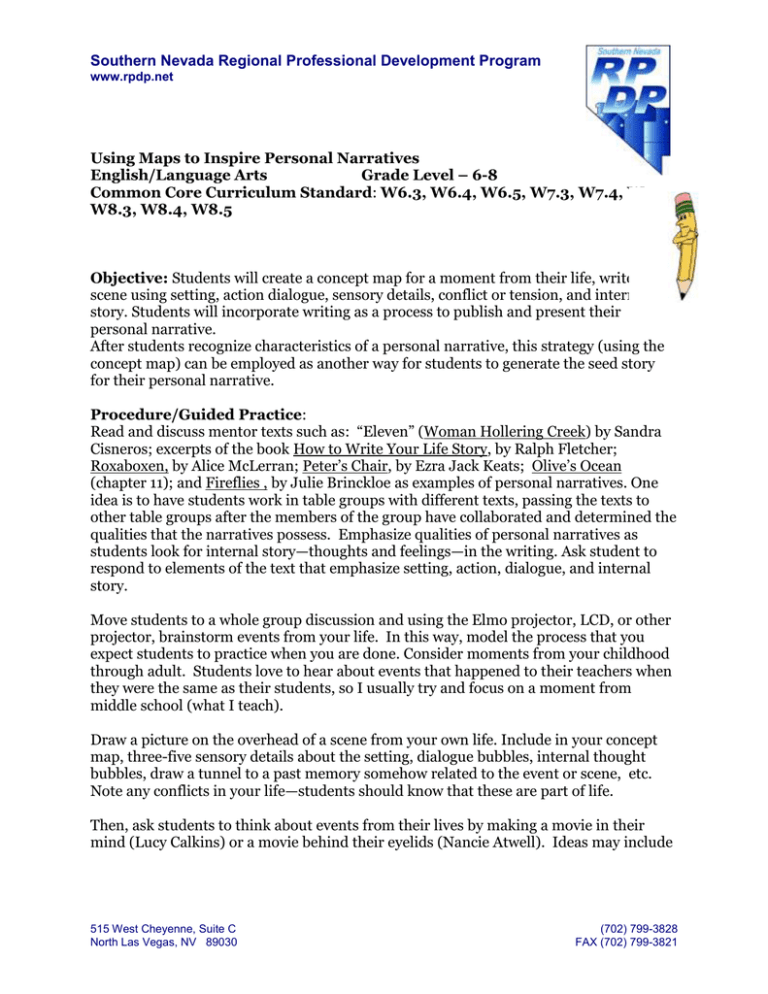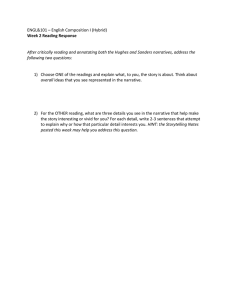Southern Nevada Regional Professional Development Program English/Language Arts
advertisement

Southern Nevada Regional Professional Development Program www.rpdp.net Using Maps to Inspire Personal Narratives English/Language Arts Grade Level – 6-8 Common Core Curriculum Standard: W6.3, W6.4, W6.5, W7.3, W7.4, W7.5 W8.3, W8.4, W8.5 Objective: Students will create a concept map for a moment from their life, write the scene using setting, action dialogue, sensory details, conflict or tension, and internal story. Students will incorporate writing as a process to publish and present their personal narrative. After students recognize characteristics of a personal narrative, this strategy (using the concept map) can be employed as another way for students to generate the seed story for their personal narrative. Procedure/Guided Practice: Read and discuss mentor texts such as: “Eleven” (Woman Hollering Creek) by Sandra Cisneros; excerpts of the book How to Write Your Life Story, by Ralph Fletcher; Roxaboxen, by Alice McLerran; Peter’s Chair, by Ezra Jack Keats; Olive’s Ocean (chapter 11); and Fireflies , by Julie Brinckloe as examples of personal narratives. One idea is to have students work in table groups with different texts, passing the texts to other table groups after the members of the group have collaborated and determined the qualities that the narratives possess. Emphasize qualities of personal narratives as students look for internal story—thoughts and feelings—in the writing. Ask student to respond to elements of the text that emphasize setting, action, dialogue, and internal story. Move students to a whole group discussion and using the Elmo projector, LCD, or other projector, brainstorm events from your life. In this way, model the process that you expect students to practice when you are done. Consider moments from your childhood through adult. Students love to hear about events that happened to their teachers when they were the same as their students, so I usually try and focus on a moment from middle school (what I teach). Draw a picture on the overhead of a scene from your own life. Include in your concept map, three-five sensory details about the setting, dialogue bubbles, internal thought bubbles, draw a tunnel to a past memory somehow related to the event or scene, etc. Note any conflicts in your life—students should know that these are part of life. Then, ask students to think about events from their lives by making a movie in their mind (Lucy Calkins) or a movie behind their eyelids (Nancie Atwell). Ideas may include 515 West Cheyenne, Suite C North Las Vegas, NV 89030 (702) 799-3828 FAX (702) 799-3821 Southern Nevada Regional Professional Development Program www.rpdp.net the birth of siblings, first day of school, first day in a new place;, a wedding, a divorce, the death of a loved one, an earthquake or some other kind of extreme weather, the break-up of a friendship, the beginning of a new friendship, a time the student got into trouble, a time the student won an award or game, or competition, a new house or new place, etc. Notebook Page Ask students to draw a similar picture, depicting a scene from their own life, in their writer’s notebook. Have them label the sensory details, the internal thoughts—what they were thinking then and what they are thinking now-- the dialogue, and the link to the past. Next, model writing a narrative based on your overhead concept map. Think aloud as you write, referring back to the elements in your drawing. You may want to start in the middle of the action, in the middle of the dialogue or private thought. Model all the strategies that you have taught them—write the seed story, go back and create a lead, and an ending. Revise your paper by including internal thoughts and story. Permit students to see the good, the bad, and the ugly as you authentically create while they watch. After you model the narrative writing, have students write their own narrative based on their drawings. This will most likely take more than one class period as they write the movie in their mind based on the concept map. A next step in the lesson is to refer back to your narrative in its rough form. I provide students a copy of my narrative and ask them to work with their table group to decide on at least three questions that can be explored further to revise the narrative. Ask students to draft their questions and think aloud about how you might answer those questions in the revision process. Students can take turns presenting their questions to the whole group and to you, and watch as you attempt revisions on your own paper via the projector. The final step in the lesson, before students publish and edit/revise their papers is to have students peer evaluation each other’s papers based on the narrative checklist (rubric) that they have been given for this narrative. Have students switch papers, read each other's narrative, and write down three questions to help their peer develop their narratives further. 515 West Cheyenne, Suite C North Las Vegas, NV 89030 (702) 799-3828 FAX (702) 799-3821




